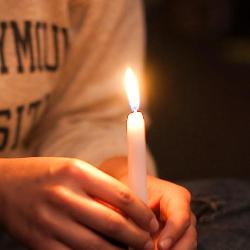Back to Our Why

Back to Our Why
As we enter the joyful season of Easter and the beginning of spring, and with promising news on the horizon, what grounds us? Where are our roots? Alyssa Perez, Interim Assistant Director of Alternative Breaks in the Center for Service and Action, reminds us to look back to where we draw strength, reconnecting with our why, in order to move forward with love and a steadfast spirit.
✜
My partner has been going through RCIA (the Rite of Christian Initiation for Adults) to receive his Confirmation this spring. I am always a little thrown off when I meet people who didn’t receive the sacraments of initiation (Baptism, First Communion, and Confirmation) when they were younger. At first, I thought it would be hard to go back to RCIA as an adult, but I actually realized what a great privilege it is. When we are older, we are more fully and intentionally saying yes to God. Not to take away from my own Confirmation experience as a teenager, but it has been a blessing to witness my partner, as an adult, reconnect with God in his faith and re-confirm his “yes I believe” and this is why.
Throughout the season of Lent, the Ignatian Solidarity Network has been reflecting on a steadfast spirit, rooted in love. What exactly is steadfast, though? It means, “dutifully firm, unwavering, determined.” How can we root ourselves more deeply in a steadfast love? The answer is in the “root”—where are your roots? It is easier, like a tree, to stand upright and unwavering when you have strong roots.

The gospel reading for Easter Monday (Matthew 28:8-15), as Jesus first appears to the disciples after his resurrection, calls us back to our why. Jesus is calling us back to where it all began for us. When I first reflected on this passage, I was a little confused by Jesus’ actions. This amazing miracle had happened—Jesus had risen from the dead—and yet his one request to the disciples when he saw them was, “Do not be afraid. Go tell my brothers to go to Galilee, and there they will see me.” But, why Galilee? They are just finally seeing him risen, why is he sending them off somewhere else?
I started to do a little more searching into the significance of Galilee. It dawned on me—that was the place where it all began for Jesus—his public ministry, his miracles, and the call of the disciples. He was essentially telling the disciples to go back to their hometown, where it all started for them, and revisit the place where they were first called by God. But why? I like to think that it was so that they could re-discover their call, to remember their “why” so that they could continue in their ministry with a renewed sense of their love in God.
Let us move forward in this Easter season by going backward. Go back—in prayer, in pilgrimage, in meditation—to your Galilee. Where did your faith journey begin? In order for us to remain steadfast in the love that we are called to, we need to remember why we chose to become followers of Christ in the first place.
So now I ask you, “What is your why? Where did it all begin for you?”
If you don’t remember, let this challenge stir in you for a while. Why don’t you recall your why? Are you so far from it you forgot? Did you never really know your why in the first place? May this Gospel narrative be the call that we needed to go back to our God and re-confirm our faith in Her. God is waiting for us there, at our Galilee—so do not be afraid!
We are rooted in our faith through our why. May we, as ISN invites us, respond to the Gospel call with a steadfast spirit, deeply rooted in love and transcending injustice, renewing a commitment to care for both our fellow human beings and our common home.
Amen!
- Alyssa Perez
This reflection originally appeared as part of the Ignatian Solidarity Network’s 2021 Lenten series, “Steadfast: A Call to Love.” You can read all the entries in this series here.
✜
To receive Manresa Moments by email, sign up here.

